Impact of Spatial Soil Variability on Rainfed Maize Yield in Kansas under a Changing Climate
Abstract
1. Introduction
2. Materials and Methods
2.1. Study Area
2.2. DSSAT CERES-Maize Cropping System Model
2.2.1. Model Description
2.2.2. Climate Data
2.2.3. Soils Data
2.2.4. Crop Management Data
2.2.5. Cultivar Calibration
2.2.6. Model Evaluation and Statistical Analysis
3. Results and Discussion
3.1. DSSAT Performance
3.2. Impact of Soil Variability on Maize Yield
3.3. Projected Changes in Temperature and Precipitation
3.4. Climate Change Impact on Maize Yield
3.5. Mapping Future Rainfed Maize Yield Variability
4. Conclusions
Author Contributions
Funding
Institutional Review Board Statement
Informed Consent Statement
Data Availability Statement
Acknowledgments
Conflicts of Interest
References
- Reillya, J.; Paltseva, S.; Felzerb, B.; Wanga, X.; Kicklighterb, D.; Melillob, J.; Prinna, R.; Sarofima, M.; Sokolova, A.; Wanga, C. Global economic effects of changes in crops, pasture, and forests due to changing climate, carbon dioxide, and ozone. Energy Policy 2007, 35, 5370–5383. [Google Scholar] [CrossRef]
- Leakey, A.D.B. Rising atmospheric carbon dioxide concentration and the future of C4 crops for food and fuel. Proc. R. Soc. B Biol. Sci. 2009, 276, 2333–2343. [Google Scholar] [CrossRef] [PubMed]
- Rogers, A.; Ainsworth, E.A.; Leakey, A.D. Will elevated carbon dioxide concentration amplify the benefits of nitrogen fixation in legumes? Plant Physiol. 2009, 151, 1009–1016. [Google Scholar] [CrossRef] [PubMed]
- Gornall, J.; Betts, R.; Burke, E.; Clark, R.; Camp, J.; Willett, K.; Wiltshire, A. Implications of climate change for agricultural productivity in the early twenty-first century. Philos. Trans. R. Soc. B Biol. Sci. 2010, 365, 2973–2989. [Google Scholar] [CrossRef] [PubMed]
- Hatfield, J.L.; Dold, C. Climate Impacts on Agriculture: Implications for Crop Production. Agron. J. 2011, 103, 351–370. [Google Scholar] [CrossRef]
- Sen, R.; Karim, N.N.; Islam, M.T.; Adham, A.K.M. Estimation of supplemental irrigation for Aman rice cultivation in Bogra and Dinajpur districts of Bangladesh. Progressive Agriculture. 2017, 28, 42–54. [Google Scholar] [CrossRef]
- Sakurai, G.; Iizumi, T.; Nishimori, M.; Yokozawa. How much has the increase in atmospheric CO2 directly affected past soybean production? Sci. Rep. 2014, 4, 4978. [Google Scholar] [CrossRef]
- Kellogg, W.W. Climate Change and Society: Consequences of Increasing Atmospheric Carbon Dioxide; Routledge: New York, NY, USA, 2019. [Google Scholar] [CrossRef]
- Schauberger, B.; Archontoulis, S.; Arneth, A.; Balkovic, J.; Ciais, P.; Deryng, D.; Frieler, K. Consistent negative response of US crops to high temperatures in observations and crop models. Nat. Commun. 2017, 8, 13931. [Google Scholar] [CrossRef]
- Oduro, C.; Shuoben, B.; Ayugi, B.; Beibei, L.; Babaousmail, H.; Sarfo, I.; Ngoma, H. Observed and Coupled Model Intercomparison Project 6 multimodel simulated changes in near-surface temperature properties over Ghana during the 20th century. Int. J. Clim. 2022, 42, 3681–3701. [Google Scholar] [CrossRef]
- Finger, R. Modeling the sensitivity of agricultural water use to price variability and climate change—An application to Swiss maize production. Agric. Water Manag. 2012, 109, 135–143. [Google Scholar] [CrossRef]
- Wang, M.; Li, Y.; Ye, W.; Bornman, J.F.; Yan, X. Effects of climate change on maize production, and potential adaptation measures: A case study in Jilin Province, China. Clim. Res. 2011, 46, 223–242. [Google Scholar] [CrossRef]
- Sabagh, A.E.; Hossain, A.; Iqbal, M.A.; Barutçular, C.; Islam, M.S.; Çiğ, F.; Saneoka, H. Maize adaptability to heat stress under changing climate. In Plant Stress Physiology; IntechOpen: London, UK, 2020. [Google Scholar]
- USDA National Agricultural Statistics Service, 2019 Census of Agriculture. 2019. Available online: www.nass.usda.gov/AgCensus (accessed on 26 June 2021).
- Ranum, P.; Peña-Rosas, J.P.; Garcia-Casal, M.N. Global maize production, utilization, and consumption. Ann. N. Y. Acad. Sci. 2014, 1312, 105–112. [Google Scholar] [CrossRef] [PubMed]
- Lin, X.; Harrington, J.; Ciampitti, I.; Gowda, P.; Brown, D.; Kisekka, I. Kansas trends and changes in temperature, precipitation, drought, and frost-free days from the 1890s to 2015. J. Contemp. Water Res. Educ. 2017, 162, 18–30. [Google Scholar] [CrossRef]
- Anderson, T.R.; Hawkins, E.; Jones, P.D. CO2, the greenhouse effect and global warming: From the pioneering work of Arrhenius and Callendar to today’s Earth System Models. Endeavour 2016, 40, 178–187. [Google Scholar] [CrossRef]
- Lobell, D.B.; Hammer, G.L.; McLean, G.; Messina, C.; Roberts, M.J.; Schlenker, W. The critical role of extreme heat for maize production in the United States. Nat. Clim. Change 2013, 3, 497–501. [Google Scholar] [CrossRef]
- Asseng, S.; Zhu, Y.; Basso, B.; Wilson, T.; Cammarano, D. Simulation Modeling: Applications in Cropping Systems. In Encyclopedia of Agriculture and Food Systems; Elsevier: Amsterdam, The Netherlands, 2014; pp. 102–112. [Google Scholar] [CrossRef]
- Challinor, A.J.; Watson, J.; Lobell, D.B.; Howden, S.M.; Smith, D.R.; Chhetri, N. A meta-analysis of crop yield under climate change and adaptation. Nat. Clim. Chang. 2014, 4, 287–291. [Google Scholar] [CrossRef]
- Armstrong, R.D.; Fitzpatrick, J.; Rab, M.A.; Abuzar, M.; Fisher, P.D.; O’Leary, G.J. Advances in precision agriculture in south-eastern Australia. III. Interactions between soil properties and water use help explain spatial variability of crop production in the Victorian Mallee. Crop Pasture Sci. 2009, 60, 870–884. [Google Scholar] [CrossRef]
- Sen, R.; Karim, N.N.; Islam, M.T.; Rahman, M.M.; Adham, A.K.M. Estimation of actual crop evapotranspiration and supplemental irrigation for Aman rice cultivation in the northern part of Bangladesh. Fundam. Appl. Agric. 2019, 4, 873–880. [Google Scholar] [CrossRef]
- Milewski, R.; Schmid, T.; Chabrillat, S.; Jiménez, M.; Escribano, P.; Pelayo, M.; Ben-Dor, E. Analyses of the Impact of Soil Conditions and Soil Degradation on Vegetation Vitality and Crop Productivity Based on Airborne Hyperspectral VNIR–SWIR–TIR Data in a Semi-Arid Rainfed Agricultural Area (Camarena, Central Spain). Remote Sens. 2022, 14, 5131. [Google Scholar] [CrossRef]
- Huang, B.; Sun, W.; Zhao, Y.; Zhu, J.; Yang, R.; Zou, Z.; Su, J. Temporal and spatial variability of soil organic matter and total nitrogen in an agricultural ecosystem as affected by farming practices. Geoderma 2007, 139, 336–345. [Google Scholar] [CrossRef]
- Butcher, K.; Wick, A.F.; DeSutter, T.; Chatterjee, A.; Harmon, J. Corn and soybean yield response to salinity influenced by soil texture. Agron. J. 2018, 110, 1243–1253. [Google Scholar] [CrossRef]
- Marschner, P.; Rengel, Z. Nutrient availability in soils. In Marschner’s Mineral Nutrition of Plants; Academic Press: Cambridge, MA, USA, 2023; pp. 499–522. [Google Scholar]
- Schyns, J.F.; Hoekstra, A.Y.; Booij, M.J.; Hogeboom, R.J.; Mekonnen, M.M. Limits to the world’s green water resources for food, feed, fiber, timber, and bioenergy. Proc. Natl. Acad. Sci. USA 2019, 116, 4893–4898. [Google Scholar] [CrossRef] [PubMed]
- Rounsevell, M.D.A.; Annetts, J.E.; Audsley, E.; Mayr, T.; Reginster, I. Modelling the spatial distribution of agricultural land use at the regional scale. Agric. Ecosyst. Environ. 2003, 95, 465–479. [Google Scholar] [CrossRef]
- Amin, A.; Nasim, W.; Mubeen, M.; Nadeem, M.; Ali, L.; Hammad, H.M.; Fathi, A. Optimizing the phosphorus use in cotton by using CSM-CROPGRO-cotton model for semi-arid climate of Vehari-Punjab, Pakistan. Environ. Sci. Pollut. Res. 2017, 24, 5811–5823. [Google Scholar] [CrossRef]
- Jones, J.W.; Hoogenboom, G.; Porter, C.H.; Boote, K.J.; Batchelor, W.D.; Hunt, L.A.; Wilkens, P.W.; Singh, U.; Gijsman, A.J.; Ritchie, J.T. The DSSAT cropping system model. Eur. J. Agron. 2003, 18, 235–265. [Google Scholar] [CrossRef]
- Modala, N.R.; Ale, S.; Rajan, N.; Munster, C.L.; DeLaune, P.B.; Thorp, K.R.; Barnes, E.M. Evaluation of the CSM-CROPGRO-Cotton model for the Texas rolling plains region and simulation of deficit irrigation strategies for increasing water use efficiency. Trans. ASABE 2015, 58, 685–696. [Google Scholar]
- Pathak, T.B.; Fraisse, C.W.; Jones, J.W.; Messina, C.D.; Hoogenboom, G. Use of global sensitivity analysis for CROPGRO cotton model development. Trans. ASABE 2007, 50, 2295–2302. [Google Scholar] [CrossRef]
- Boonwichai, S.; Shrestha, S.; Babel, M.S.; Weesakul, S.; Datta, A. Climate change impacts on irrigation water requirement, crop water productivity and rice yield in the Songkhram River Basin, Thailand. J. Clean. Prod. 2018, 198, 1157–1164. [Google Scholar] [CrossRef]
- Carbone, G.J.; Kiechle, W.; Locke, C.; Mearns, L.O.; McDaniel, L.; Downton, M.W. Response of soybean and sorghum to varying spatial scales of climate change scenarios in the southeastern United States. In Issues in the Impacts of Climate Variability and Change on Agriculture; Springer: Dordrecht, The Netherlands, 2003. [Google Scholar]
- Sarkar, R.; Kar, S. Evaluation of management strategies for sustainable rice–wheat cropping system, using DSSAT seasonal analysis. J. Agric. Sci. 2006, 144, 421–434. [Google Scholar] [CrossRef]
- Yakoub, A.; Lloveras, J.; Biau, A.; Lindquist, J.L.; Lizaso, J.I. Testing and improving the maize models in DSSAT: Development, growth, yield, and N uptake. Field Crops Res. 2017, 212, 95–106. [Google Scholar] [CrossRef]
- Anothai, J.; Patanothai, A.; Jogloy, S.; Pannangpetch, K.; Boote, K.J.; Hoogenboom, G. A sequential approach for determining the cultivar coefficients of peanut lines using end-of-season data of crop performance trials. Field Crops Res. 2008, 108, 169–178. [Google Scholar] [CrossRef]
- Sharda, V.; Handyside, C.; Chaves, B.; McNider, R.T.; Hoogenboom, G. The impact of spatial soil variability on simulation of regional maize yield. Trans. ASABE 2017, 60, 2137–2148. [Google Scholar] [CrossRef]
- Southworth, J.; Pfeifer, R.A.; Habeck, M.; Randolph, J.C.; Doering, O.C.; Johnston, J.J.; Rao, D.G. Changes in soybean yields in the midwestern United States as a result of future changes in climate, climate variability, and CO2 fertilization. Clim. Chang. 2002, 53, 447–475. [Google Scholar] [CrossRef]
- Araya, A.; Kisekka, I.; Gowda, P.H.; Prasad, P.V. Evaluation of water-limited cropping systems in a semi-arid climate using DSSAT-CSM. Agric. Syst. 2017, 150, 86–98. [Google Scholar] [CrossRef]
- Araya, A.; Prasad, P.V.V.; Gowda, P.H.; Sharda, V.; Rice, C.W.; Ciampitti, I.A. Evaluating optimal irrigation strategies for maize in Western Kansas. Agric. Water Manag. 2021, 246, 106677. [Google Scholar] [CrossRef]
- Howard, J.C.; Cakan, E.; Upadhyaya, K. Climate change and its impact on wheat production in Kansas. Int. J. of Food and Agri. Eco. 2016, 4, 1–10. [Google Scholar]
- Hoogenboom, G.; Porter, C.H.; Shelia, V.; Boote, K.J.; Singh, U.; White, J.W.; Pavan, W.; Oliveira, F.A.A.; Moreno-Chain, V.; Lizaso, V.; et al. Decision Support System for Agrotechnology Transfer (DSSAT) Version 4.8 (DSSAT.Net); DSSAT Foundation: Gainesville, FL, USA, 2021. [Google Scholar]
- Abatzoglou, J.T.; Brown, T.J. A comparison of statistical downscaling methods suited for wildfire applications. Int. J. Climatol. 2012, 32, 772–780. [Google Scholar] [CrossRef]
- Taylor, I.H.; Burke, E.; McColl, L.; Falloon, P.; Harris, G.R.; McNeall, D. Contributions to uncertainty in projections of future drought under climate change scenarios. Hydrol. Earth Syst. Sci. Discuss. 2012, 9, 12613–12653. [Google Scholar]
- Ormsby, T.; Napoleon, E.; Burke, R.; Groessl, C.; Bowden, L. Getting to know ArcGIS desktop; Esri Press: Redlands, CA, USA, 2010; p. 592. [Google Scholar]
- Soil Survey Staff. Gridded Soil Survey Geographic (gSSURGO) Database for the United States of America and the Territories, Commonwealths, and Island Nations served by the USDA-NRCS. United States Department of Agriculture, Natural Resources Conservation Service. Available online: https://gdg.sc.egov.usda.gov/ (accessed on 16 November 2020).
- Van Rossum, G.; Drake, F.L., Jr. Python Tutorial; Centrum voor Wiskunde en Informatica: Amsterdam, The Netherlands, 1995. [Google Scholar]
- USDA National Agricultural Statistics Service. Cropland Data Layer; Published Crop-Specific Data Layer [Online]; USDA-NASS: Washington, DC, USA, 2019. Available online: http://nassgeodata.gmu.edu/CropScape/ (accessed on 26 June 2021).
- Ciampitti, I.A.; Correndo, A.; Lancaster, S.; Diaz, D.R.; Aguilar, J.; Sharda, A.; Onofre, R.; McCornack, B. Kansas Corn Management 2023; Kansas State University: Manhattan, KS, USA, 2023. [Google Scholar]
- USDA National Agricultural Statistics Service. Quickstats 2.0; USDA National Agricultural Statistics Service: Washington, DC, USA, 2016. Available online: http://www.nass.usda.gov/Quick_Stats/ (accessed on 16 December 2021).
- Hunt, L.A.; Pararajasingham, S.; Jones, J.W.; Hoogenboom, G.; Imamura, D.T.; Ogoshi, R.M. GENCALC: Software to facilitate the use of crop models for analyzing field experiments. Agron. J. 1993, 85, 1090–1094. [Google Scholar] [CrossRef]
- Bao, S.; Cao, C.; Huang, J.; Ni, X.; Xu, M. Research on yields estimation and yields increasing potential by irrigation of spring maize in Northeast China. In Proceedings of the 2016 IEEE International Geoscience and Remote Sensing Symposium (IGARSS), Beijing, China, 10–15 July 2016; pp. 2506–2509. [Google Scholar]
- Adnan, A.A.; Diels, J.; Jibrin, J.M.; Kamara, A.Y.; Craufurd, P.; Shaibu, A.S.; Tonnang, Z.E.H. Options for calibrating CERES-maize genotype specific parameters under data-scarce environments. PLoS ONE 2019, 14, e0200118. [Google Scholar] [CrossRef]
- Yang, J.M.; Yang, J.Y.; Liu, S.; Hoogenboom, G. An evaluation of the statistical methods for testing the performance of crop models with observed data. Agric. Syst. 2014, 127, 81–89. [Google Scholar] [CrossRef]
- Soler, C.M.T.; Sentelhas, P.C.; Hoogenboom, G. Application of the CSM-CERES-Maize model for planting date evaluation and yield forecasting for maize grown off-season in a subtropical environment. Eur. J. Agron. 2007, 27, 165–177. [Google Scholar] [CrossRef]
- Willmott, C.J. Some Comments on the Evaluation of Model Performance. Bull. Am. Meteorol. Soc. 1982, 63. [Google Scholar] [CrossRef]
- Golmohammadi, G. Development and evaluation of SWATDRAIN, a new model to simulate the hydrology of agricultural tile drained watersheds. Ph.D. Thesis, McGill University, Montreal, QC, Canada, 2014. [Google Scholar]
- Swinscow, T.D.V.; Campbell, M.J. Statistics at Square One; BMJ: London, UK, 2002; pp. 11–25. [Google Scholar]
- Malik, W.; Isla, R.; Dechmi, F. DSSAT-CERES-maize modelling to improve irrigation and nitrogen management practices under Mediterranean conditions. Agric. Water Manag. 2019, 213, 298–308. [Google Scholar] [CrossRef]
- Sharda, V.; Mekonnen, M.M.; Ray, C.; Gowda, P.H. Use of Multiple Environment Variety Trials Data to Simulate Maize Yields in the Ogallala Aquifer Region: A Two Model Approach. JAWRA J. Am. Water Resour. Assoc. 2021, 57, 281–295. [Google Scholar] [CrossRef]
- Plant, R.E. Site-specific management: The application of information technology to crop production. Comput. Electron. Agric. 2001, 30, 9–29. [Google Scholar] [CrossRef]
- Quine, T.A.; Zhang, Y. An investigation of spatial variation in soil erosion, soil properties, and crop production within an agricultural field in Devon, United Kingdom. J. Soil Water Conserv. 2002, 57, 55–65. [Google Scholar]
- Lau, N.C.; Nath, M.J. A model study of heat waves over North America: Meteorological aspects and projections for the twenty-first century. J. Clim. 2012, 25, 4761–4784. [Google Scholar] [CrossRef]
- Argüeso, D.; Di Luca, A.; Perkins-Kirkpatrick, S.E.; Evans, J.P. Seasonal mean temperature changes control future heat waves. Geophys. Res. Lett. 2016, 43, 7653–7660. [Google Scholar] [CrossRef]
- Herring, S.C.; Christidis, N.; Hoell, A.; Kossin, J.P.; Schreck III, C.J.; Stott, P.A. Explaining extreme events of 2016 from a climate perspective. Bull. Am. Meteorol. Soc. 2018, 99, S1–S157. [Google Scholar] [CrossRef]
- Almazroui, M.; Islam, M.N.; Saeed, F.; Saeed, S.; Ismail, M.; Ehsan, M.A.; Barlow, M. Projected changes in temperature and precipitation over the United States, Central America, and the Caribbean in CMIP6 GCMs. Earth Syst. Environ. 2021, 5, 1–24. [Google Scholar] [CrossRef]
- Yue, Y.; Yan, D.; Yue, Q.; Ji, G.; Wang, Z. Future changes in precipitation and temperature over the Yangtze River Basin in China based on CMIP6 GCMs. Atmos. Res. 2021, 264, 105828. [Google Scholar] [CrossRef]
- Srivastava, A.K.; Mboh, C.M.; Zhao, G.; Gaiser, T.; Ewert, F. Climate change impact under alternate realizations of climate scenarios on maize yield and biomass in Ghana. Agric. Syst. 2018, 159, 157–174. [Google Scholar] [CrossRef]
- Dale, A.; Fant, C.; Strzepek, K.; Lickley, M.; Solomon, S. Climate model uncertainty in impact assessments for agriculture: A multi-ensemble case study on maize in sub-Saharan Africa. Earth’s Future 2017, 5, 337–353. [Google Scholar] [CrossRef]


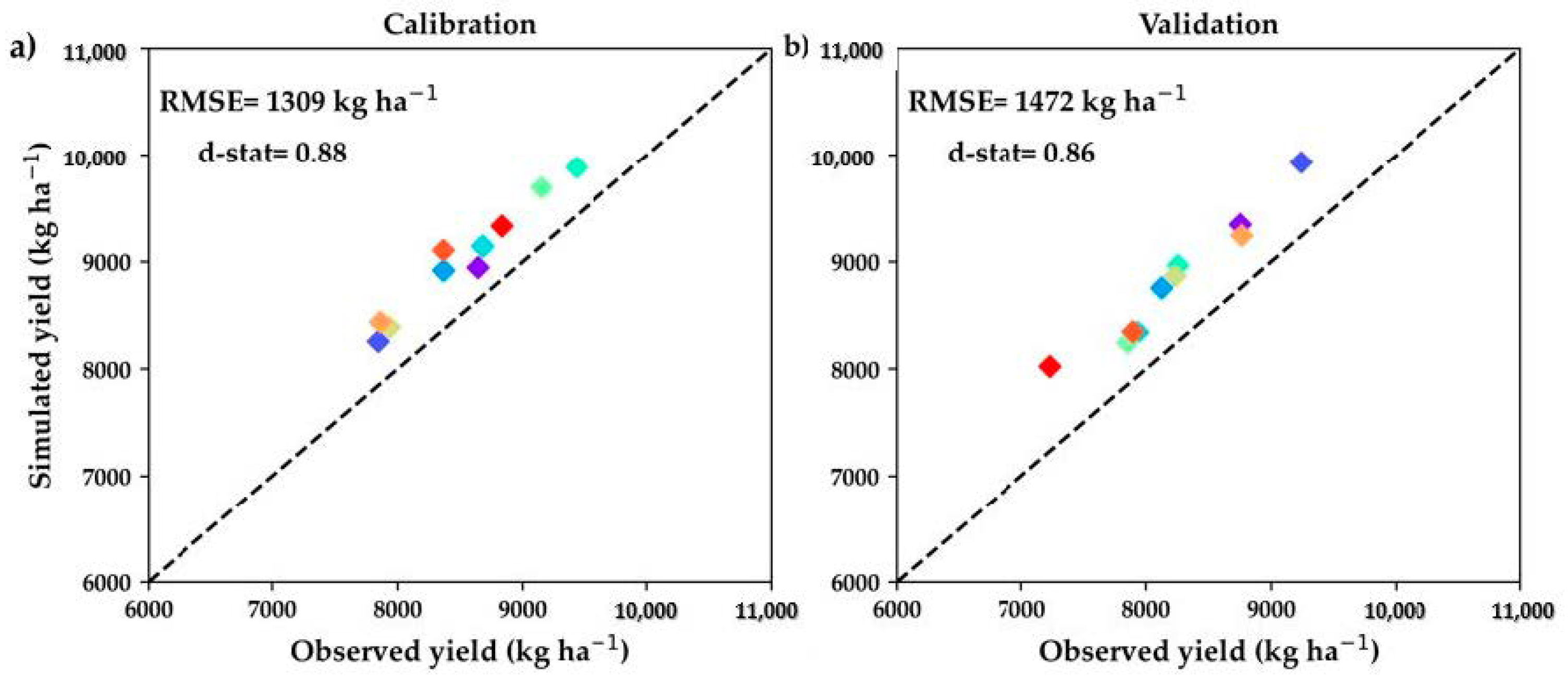

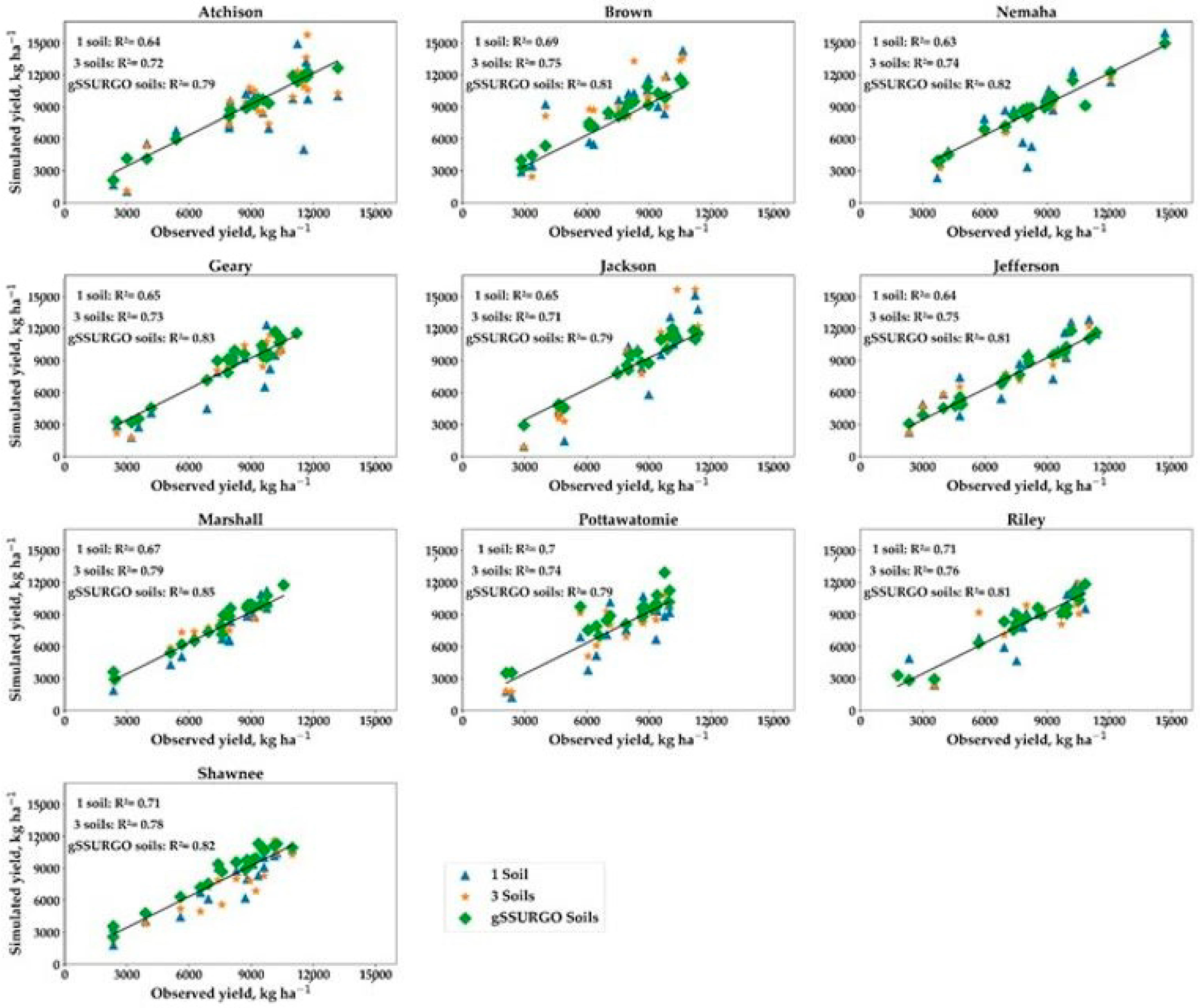
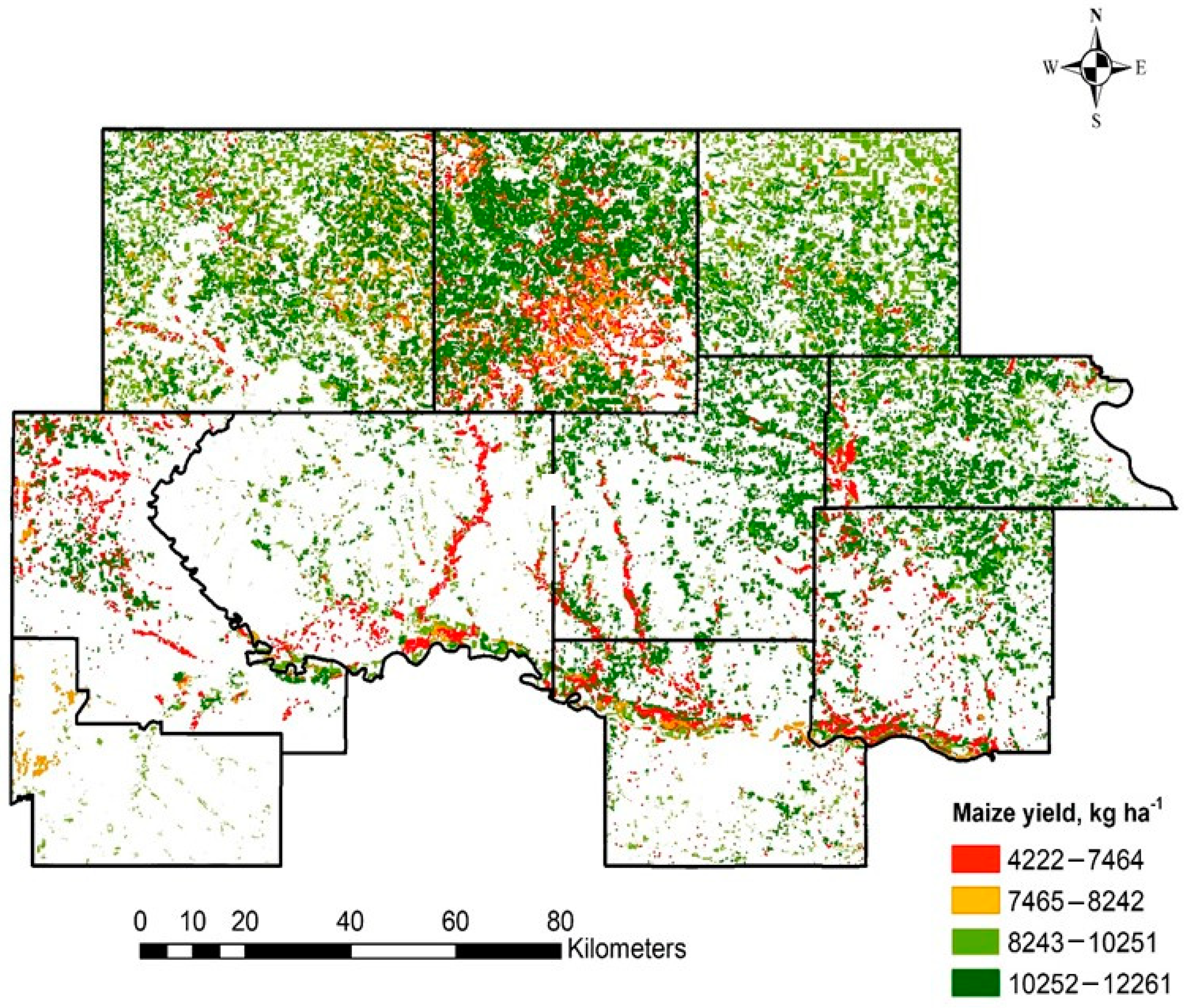
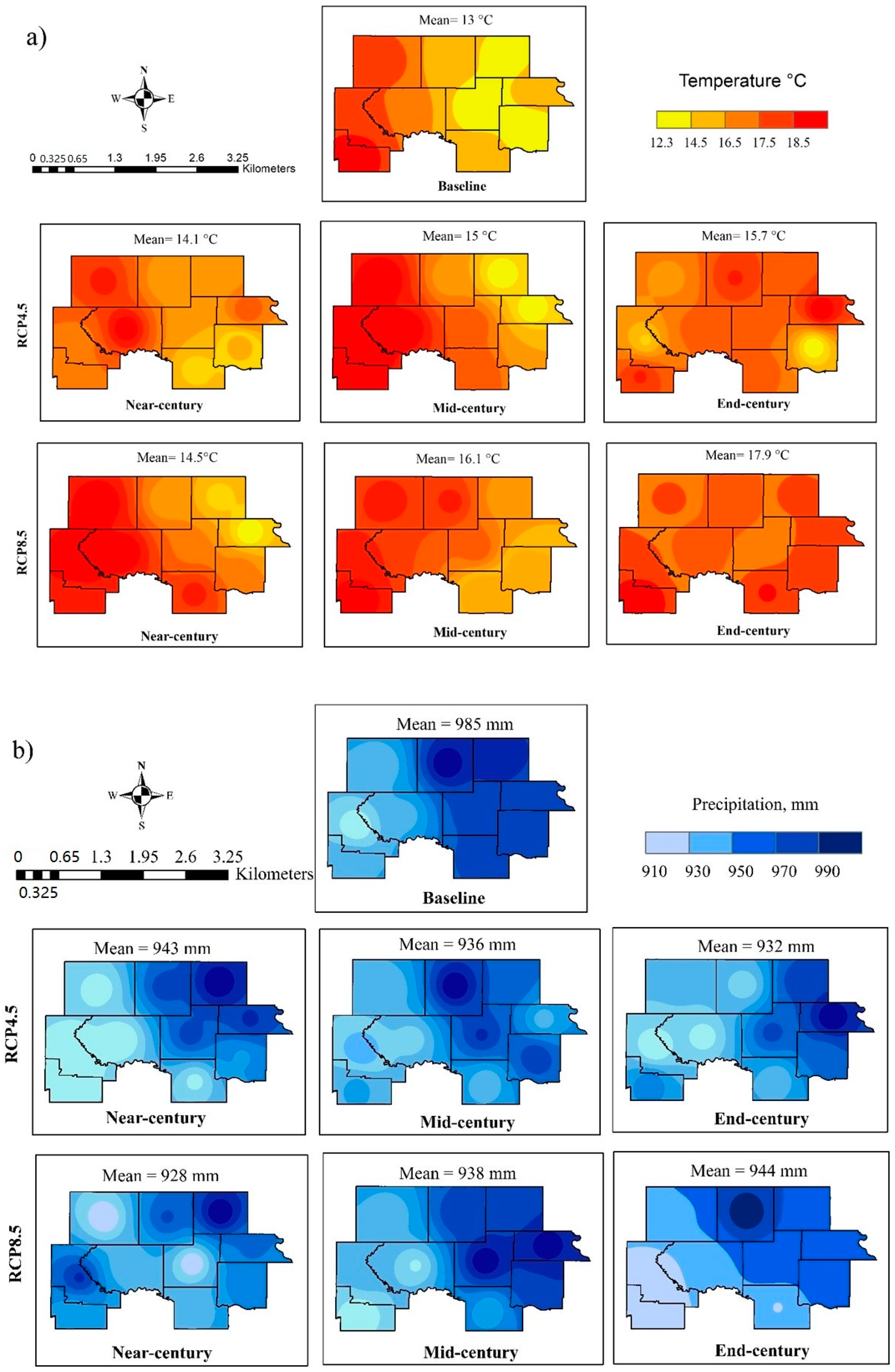
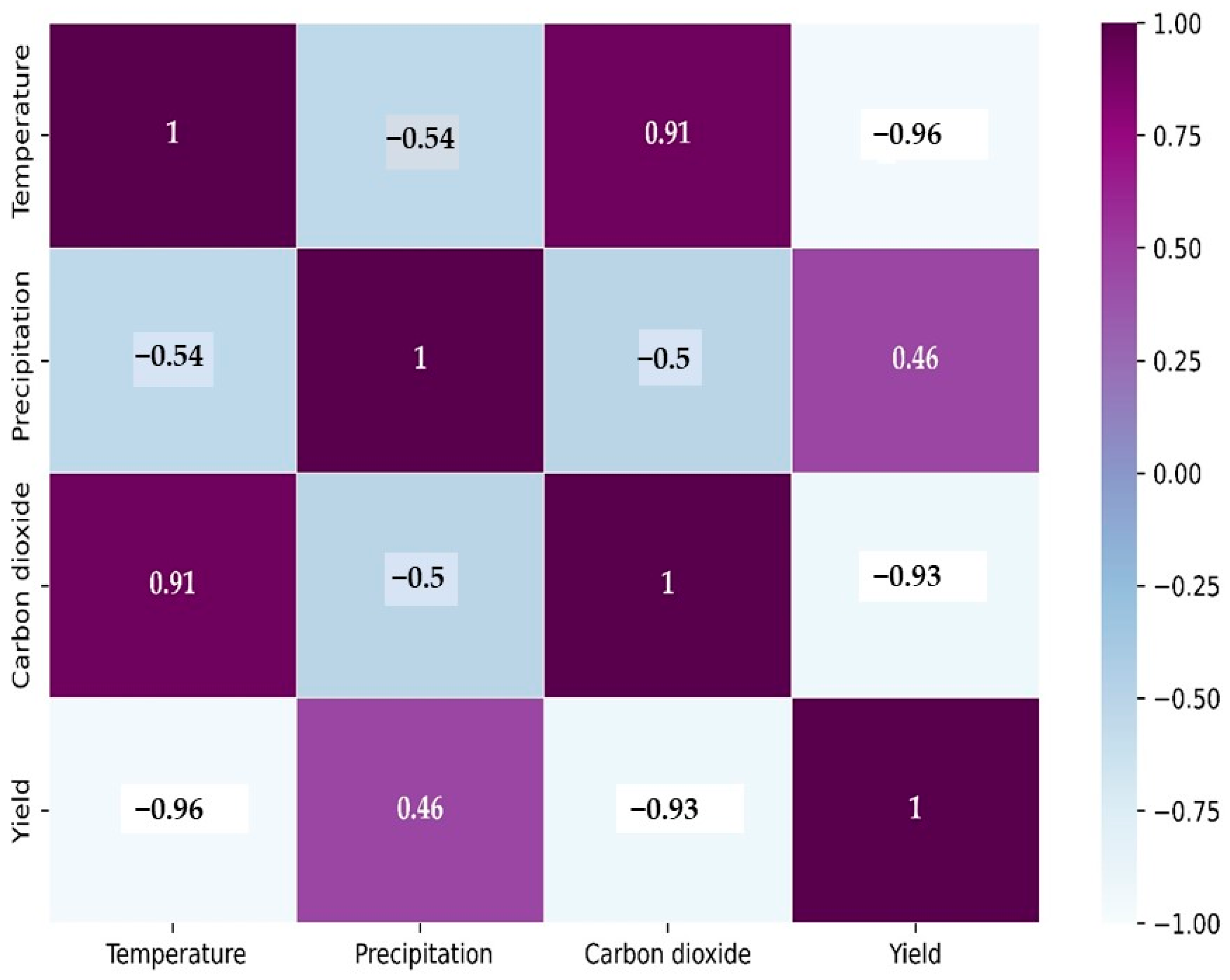


| Models | Source |
|---|---|
| BCC_CSM1.1 | Beijing Climate Center, China Meteorological Administration, China |
| BCC_CSM1.1-m | Beijing Climate Center, China Meteorological Administration, China |
| BNU-ESM | Beijing Normal University, China |
| CanESM2 | Canadian Centre for Climate Modelling and Analysis, Canada |
| CNRM-CM5 | National Centre for Meteorological Research, France |
| CSIRO-Mk3.6.0 | The Commonwealth Scientific and Industrial Research Organization, Australia |
| GFDL-ESM2G | Geophysical Fluid Dynamic Laboratory, USA |
| GFDL-ESM2M | Geophysical Fluid Dynamic Laboratory, USA |
| HadGEM2-CC365 | Met Office Hadley Center, UK |
| HadGEM2-ES365 | Met Office Hadley Center, UK |
| inmcm4 | Institute of Numerical Mathematics, Russian Academy of Sciences |
| IPSL-CM5A-LR | Institute Pierre-Simon Laplace, France |
| IPSL-CM5A-MR | Institute Pierre-Simon Laplace, France |
| IPSL-CM5B-LR | Institute Pierre-Simon Laplace, France |
| MIROC5 | Japan Agency for Marin-Earth Science and Technology, Atmosphere and Ocean Research Institute (University of Tokyo Japan) |
| MIROC-ESM | Japan Agency for Marin-Earth Science and Technology, Atmosphere and Ocean Research Institute (University of Tokyo Japan) |
| MIROC-ESM-CHEM | Japan Agency for Marin-Earth Science and Technology, Atmosphere and Ocean Research Institute (University of Tokyo Japan) |
| MRI-CGCM3 | Meteorological Research Institute of Japan |
| Coefficient | Definition | Units | Min. | Max. | Calibrated Value |
|---|---|---|---|---|---|
| P1 | Thermal time from seedling emergence to end of juvenile phase. | °C days | 5.0 | 450.0 | 270.0 |
| P2 | Extent to which development is delayed for each hour increase in photoperiod above the longest photoperiod at which development proceeds at a maximum rate. | day h−1 | 0.0 | 2.0 | 0.660 |
| P5 | Thermal time from silking to physiological maturity. | °C days | 580.0 | 999.0 | 895.0 |
| G2 | Maximum possible number of kernels per plant. | kernel plant−1 | 248.0 | 990.0 | 875.0 |
| G3 | Kernel filling rate during the linear grain filling state and under optimum conditions. | mg d−1 | 5.0 | 16.50 | 8.80 |
| PHINT | Interval in thermal time between successive leaf tip appearances. | °C days | 38.0 | 75.0 | 48.0 |
| County | Observed Yield (kg ha−1) | Simulated Yield (kg ha−1) | d-stat | RMSE | ||||||
|---|---|---|---|---|---|---|---|---|---|---|
| 1 Soil | 3 Soils | gSSU-RGO Soils | 1 Soil | 3 Soils | gSSURGO Soils | 1 Soil | 3 Soils | gSSURGO Soils | ||
| Brown | 9392 | 11,234 | 10,852 | 9884 | 0.79 | 0.82 | 0.92 | 2199 | 1689 | 781 |
| Nemaha | 7717 | 8936 | 8483 | 8168 | 0.86 | 0.86 | 0.89 | 1939 | 1384 | 976 |
| Jackson | 7609 | 8624 | 8201 | 7993 | 0.82 | 0.85 | 0.87 | 1734 | 1534 | 1326 |
| Jefferson | 7946 | 9243 | 8751 | 8447 | 0.78 | 0.82 | 0.84 | 1859 | 1418 | 1116 |
| Atchison | 8890 | 10,567 | 9545 | 9326 | 0.76 | 0.87 | 0.91 | 2012 | 1513 | 876 |
| Pottawatomie | 7368 | 8868 | 8310 | 8173 | 0.79 | 0.85 | 0.88 | 1801 | 1341 | 982 |
| Marshall | 7234 | 8279 | 7917 | 7686 | 0.80 | 0.85 | 0.87 | 1446 | 1087 | 898 |
| Shawnee | 7645 | 8767 | 8336 | 7966 | 0.78 | 0.85 | 0.90 | 1659 | 1339 | 1079 |
| Riley | 7206 | 9681 | 8467 | 7977 | 0.75 | 0.82 | 0.88 | 1309 | 1296 | 909 |
| Geary | 5777 | 7825 | 6884 | 6530 | 0.71 | 0.81 | 0.83 | 1898 | 1585 | 1212 |
| Scenarios | Study Period | Maximum Temperature °C | Total Precipitation mm | CO2 Concentration ppm | Yield kg ha−1 |
|---|---|---|---|---|---|
| Base Period | 1991−2019 | 21.92 | 676 | 412 | 8546 |
| RCP4.5 | 2010−2039 | 23.32 | 640 | 458 | 7741 |
| 2040−2069 | 24.52 | 632 | 523 | 6514 | |
| 2070−2099 | 25.02 | 623 | 538 | 6225 | |
| RCP8.5 | 2010−2039 | 23.62 | 589 | 485 | 7658 |
| 2040−2069 | 25.32 | 612 | 750 | 6164 | |
| 2070−2099 | 27.42 | 636 | 927 | 3304 |
Disclaimer/Publisher’s Note: The statements, opinions and data contained in all publications are solely those of the individual author(s) and contributor(s) and not of MDPI and/or the editor(s). MDPI and/or the editor(s) disclaim responsibility for any injury to people or property resulting from any ideas, methods, instructions or products referred to in the content. |
© 2023 by the authors. Licensee MDPI, Basel, Switzerland. This article is an open access article distributed under the terms and conditions of the Creative Commons Attribution (CC BY) license (https://creativecommons.org/licenses/by/4.0/).
Share and Cite
Sen, R.; Zambreski, Z.T.; Sharda, V. Impact of Spatial Soil Variability on Rainfed Maize Yield in Kansas under a Changing Climate. Agronomy 2023, 13, 906. https://doi.org/10.3390/agronomy13030906
Sen R, Zambreski ZT, Sharda V. Impact of Spatial Soil Variability on Rainfed Maize Yield in Kansas under a Changing Climate. Agronomy. 2023; 13(3):906. https://doi.org/10.3390/agronomy13030906
Chicago/Turabian StyleSen, Rintu, Zachary T. Zambreski, and Vaishali Sharda. 2023. "Impact of Spatial Soil Variability on Rainfed Maize Yield in Kansas under a Changing Climate" Agronomy 13, no. 3: 906. https://doi.org/10.3390/agronomy13030906
APA StyleSen, R., Zambreski, Z. T., & Sharda, V. (2023). Impact of Spatial Soil Variability on Rainfed Maize Yield in Kansas under a Changing Climate. Agronomy, 13(3), 906. https://doi.org/10.3390/agronomy13030906







